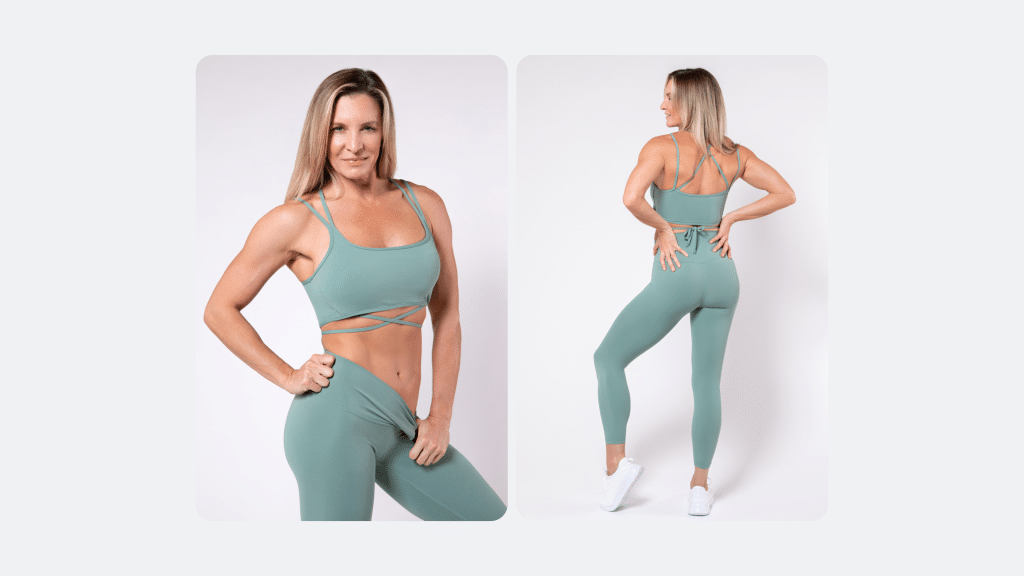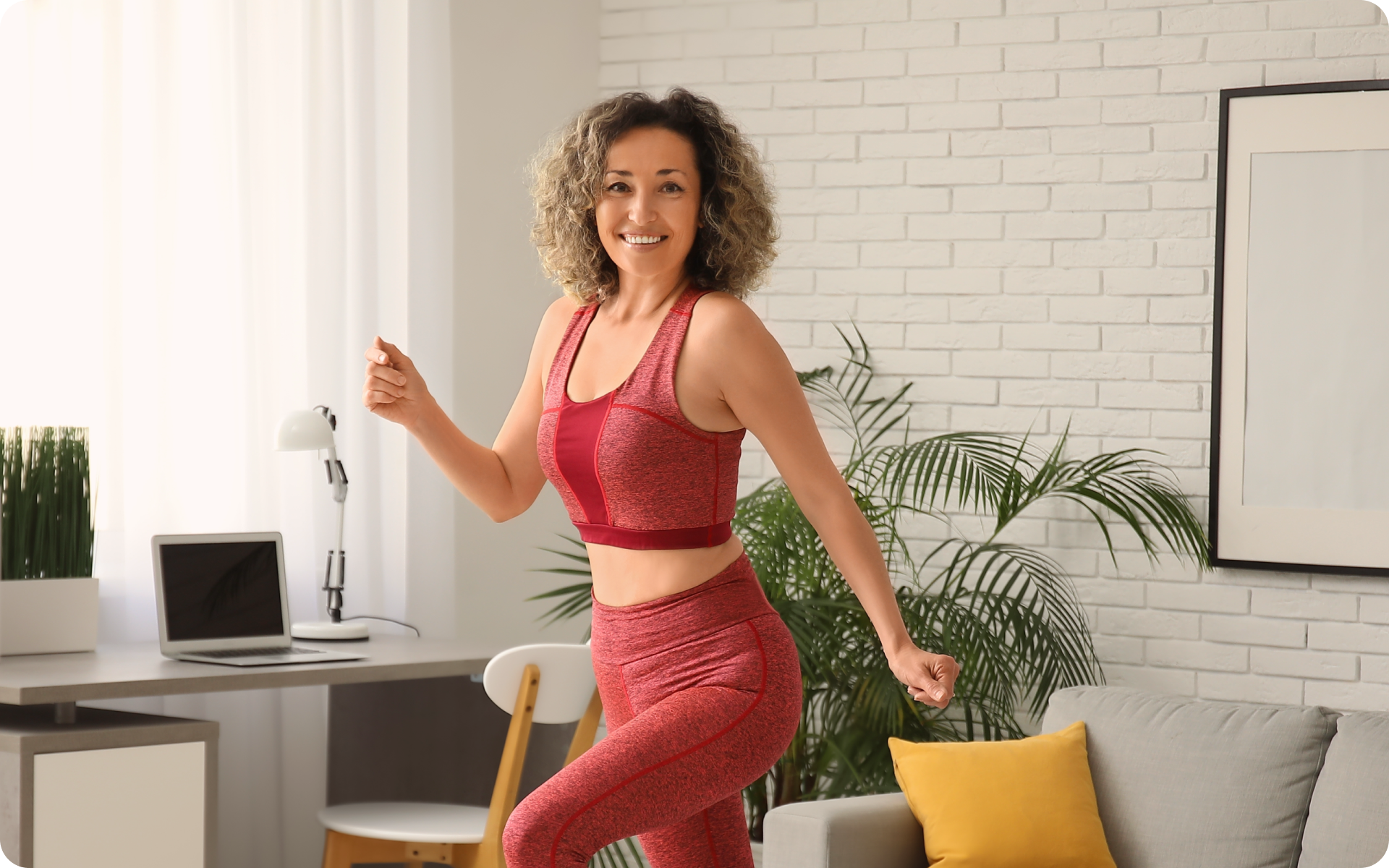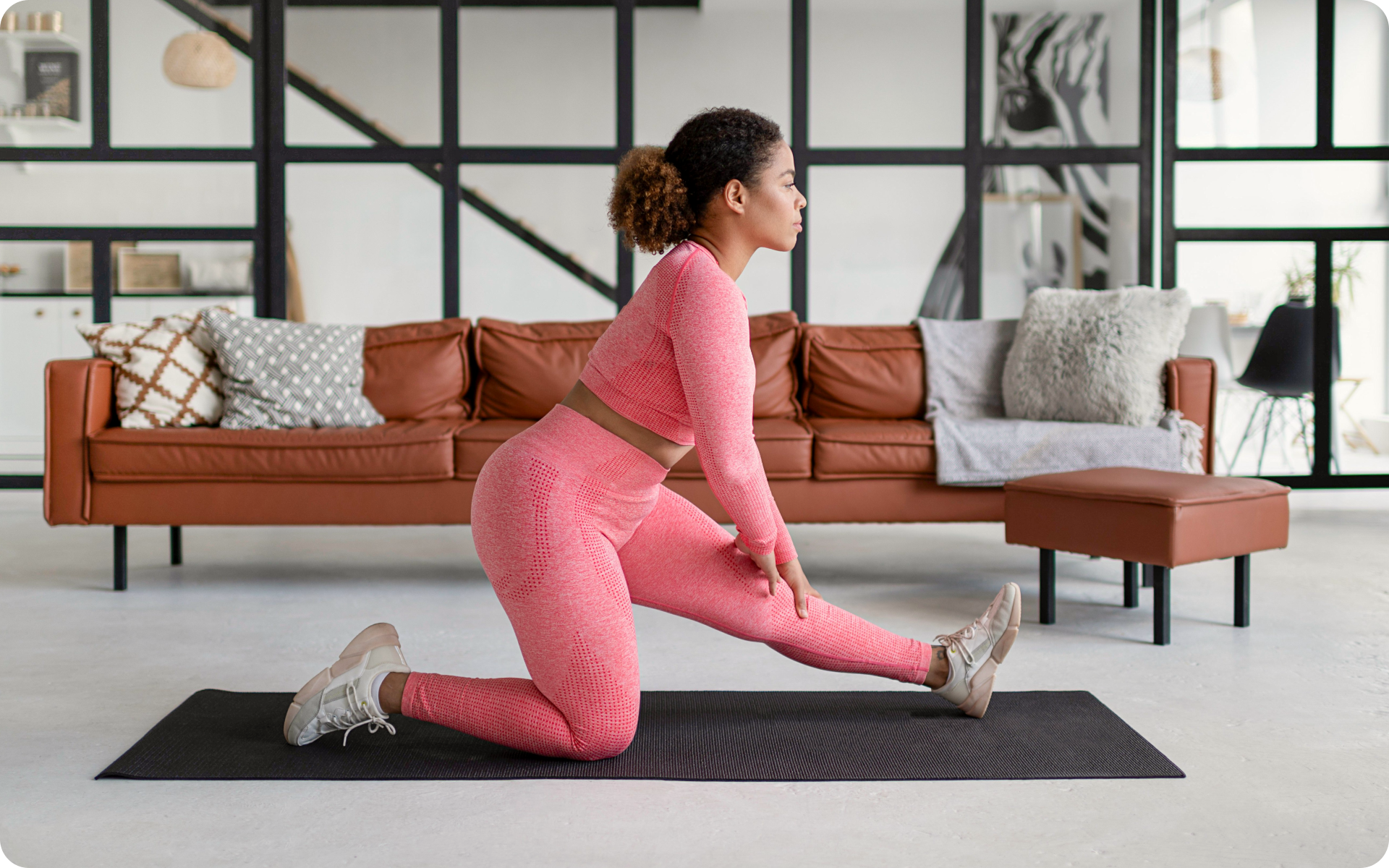Walking is an underrated exercise, particularly when compared to fancy gym equipment and high-intensity workout routines. The truth is that walking can be just as effective, if not more so, at burning calories and promoting overall health.
If for nothing else, you should consider the convenience and low-impact nature of this activity.
If you’re in any doubt, the World Health Organization recommends adults engage in at least 150 minutes of moderate-intensity aerobic physical activity a week (5), and walking fits the bill perfectly.
Other authorities echo this sentiment, emphasizing the importance of regular physical activity for maintaining a healthy weight and preventing chronic diseases (1).
Therefore, the 28-day indoor walking weight loss challenge presents an opportunity to kickstart your health journey in a way that is manageable and sustainable.
Read on to learn how you can take steps towards a healthier you, from the comfort of your own home.
What Is a 28-Day Indoor Walking Challenge?
The 28-day indoor walking weight loss challenge is a structured exercise plan involving daily walks inside your home or any other enclosed space.
The goal of this challenge is to increase your overall physical activity levels and help you shed some pounds. It can also serve as an excellent way to incorporate movement into your daily routine, particularly if you have a sedentary lifestyle.
That’s the what and why of the indoor walking workout challenge, but there’s more to it:
-
- First and foremost, it’s low-impact. Walking is gentle on your joints, which makes it suitable for people of all ages and fitness levels. This also means there is a lower risk of injuries compared to high-intensity exercises.
- It’s convenient: There’s no need for fancy equipment or a gym membership. You can do it anytime, anywhere, as long as you have enough space to move around.
- It’s versatile: You can easily modify your walking routine according to your needs and preferences. Want more of a challenge? Increase your speed or add an incline by using stairs or a small step stool.
- It’s cost-effective: Walking is free! All you need are comfortable shoes and some motivation to get moving.
- It’s sustainable: The 28-day timeframe is long enough to develop a habit, and walking is an activity that you can continue long-term without feeling burnt out.
It has numerous health benefits. Walking helps with weight loss while also improving cardiovascular health, boosting mood and cognitive function, strengthening bones and muscles, and reducing the risk of chronic diseases such as heart disease and diabetes (4).
If you struggle to even flirt with the idea of giving up your favorite foods or working out till your legs give way – BetterMe app is here to breathe a fresh perspective into the way you view the weight loss process! Check out the app and experience the fun side of fitness and dieting with BetterMe!
Does a 28-Day Walking Challenge Work?
The 28-day walking challenge works because it’s a SMART (specific, measurable, attainable, realistic, and time-bound) goal.
It’s specific, as it involves walking for a designated period of time each day. It’s measurable, as you can track your progress by monitoring the number of steps or distance covered.
It’s attainable and realistic, as it fits into most people’s daily schedules and doesn’t require any special skills or equipment. And finally, it has a set timeframe of 28 days, which provides a clear end goal and motivation to stay committed.
Can I Lose Weight by Doing Indoor Walking?
Indoor walking for weight loss is a proven method, as long as you do it in combination with a healthy diet.
According to the American Council on Exercise, a person who weighs 150 pounds can burn approximately 300 calories walking for an hour at a moderate pace (3). It gets better: walking can also boost your metabolism, which makes it easier to maintain weight loss in the long term. In addition, as you build endurance and increase the intensity of your walks, you’ll continue burning more calories.
How Much Weight Can I Lose In 1 Month By Walking?
You can lose anywhere from 4 to 8 pounds in one month by walking regularly and combining it with a healthy diet.
Of course, individual results may vary depending on factors such as starting weight, fitness level, and calorie intake. However, incorporating walking into a sedentary lifestyle should lead to weight loss over time.
In addition to directly burning calories, walking has indirect benefits that contribute to weight loss. For example, it can reduce stress and improve sleep quality, both of which are associated with weight gain. Furthermore, walking regularly can help you build strength and stamina, which will allow you to engage in other physical activities that help with weight loss (4).
Read our Calories Burned Walking 2 Miles blog to learn more about the relationship between walking and weight loss.
How Much Indoor Walking Is Needed to Lose Weight?
30 minutes of moderate to brisk walking is the recommended daily duration for weight loss. You should repeat this at least five days a week, for a total of 150 minutes per week.
However, don’t be afraid to customize your routine according to your fitness level and goals. You can increase or decrease the duration and intensity of your walks as required.
For example, if you’re just starting, you may want to walk for just 10-15 minutes and gradually work your way up. If you’ve been walking for a while and want to challenge yourself, you could walk longer, faster, or carry weights while walking.
Is the Indoor Walking Challenge Good for Seniors?
Indoor walking is a safe and effective form of exercise for seniors, as it is low-impact and easily adaptable to their fitness level.
It can help improve balance, coordination, and flexibility, which reduces the risk of falls and injuries. Regular walking can also help maintain a healthy weight, prevent chronic diseases, and improve overall well-being (2).
Indoor walking for seniors can be modified in the following ways:
- Start with shorter durations and gradually increase as needed.
- Walk at a comfortable pace that allows safe movement.
- Use support such as a cane or walker if necessary.
- Incorporate other exercises such as chair yoga, stretching, or light weightlifting.
- Consult a healthcare professional before you start any exercise routine.
Our Indoor Exercise guide has more tips and modifications for seniors who are looking to incorporate walking into their daily routine.
How to Get Started
Before you start the challenge, consulting your doctor is essential, particularly if you have any underlying health conditions. They can advise you on any modifications or precautions you may need to take.
Once cleared by your doctor, you can follow these steps to get started:
- Set a goal: Determine what you want to achieve through this challenge. Is it weight loss, improved fitness, or simply incorporating more movement into your day?
- Plan your walks: Decide on the duration and frequency of your walks. You can start with 15-20 minutes a day and gradually increase as you progress.
- Find an indoor space: Identify a suitable area at home or in your office where you can walk without interruptions or obstacles.
- Pick the right shoes: Invest in a good pair of walking shoes that provide proper support and cushioning to prevent injuries.
- Warm-up: Before each walk, spend 5-10 minutes doing some light exercises such as marching in place or stretching to prepare your muscles and joints for movement.
- Choose an indoor treadmill that works for you: If walking around your home isn’t feasible, consider an indoor treadmill or walking pad. There are many options available, which range from basic manual treadmills to high-tech models with various features.
- Consider intensity: To increase the calorie-burning potential of your walks, add some intervals where you walk at a faster pace or incorporate some body-weight exercises such as squats or lunges.
- Stay motivated and track progress: The key to completing any challenge is to remain motivated and accountable. Use a fitness tracker or journal to record your daily walks and celebrate milestones along the way.
Check out our blog Is Walking In Place a Good Exercise to decide whether walking in place or using a treadmill is the best fit for your needs.
Read more: Calories Burned Walking 1 Hour: How to Calculate the Calories You Burn While Walking
Sample 28-Day Walking Challenge Treadmill Workout for Beginners
Day 1: 15-minute walk at a moderate pace (3.5 mph)
Day 2: Rest day or light stretching exercises
Day 3: 20-minute walk at a moderate pace (3.5 mph)
Day 4: Rest day or light strength training exercises
Day 5: Two sets of 10 squats and lunges, followed by a 15-minute walk at a brisk pace (4.0 mph)
Day 6: Rest day or light stretching exercises
Day 7: 25-minute walk at a moderate pace (3.5 mph)
Day 8: Rest day or light strength training exercises
Day 9: Two sets of 10 push-ups and tricep dips, followed by a 20-minute walk at a moderate pace (3.5 mph)
Day 10: Rest day or light stretching exercises
Day 11: 30-minute walk at a brisk pace (4.0 mph)
Day 12: Rest day or light strength training exercises
Day 13: Two sets of 10 squats and lunges, followed by a 25-minute walk at a moderate pace (3.5 mph)
Day 14: Rest day or light stretching exercises
Day 15: 35-minute walk at a moderate pace (3.5 mph)
Day 16: Rest day or light strength training exercises
Day 17: Two sets of 10 push-ups and tricep dips, followed by a 30-minute walk at a brisk pace (4.0 mph)
Day 18: Rest day or light stretching exercises
Day 19: 40-minute walk at a moderate pace (3.5 mph)
Day 20: Rest day or light strength training exercises
Day 21: Two sets of 10 squats and lunges, followed by a 35-minute walk at a moderate pace (3.5 mph)
Day 22: Rest day or light stretching exercises
Day 23: 45-minute walk at a brisk pace (4.0 mph)
Day 24: Rest day or light strength training exercises
Whether you’re a workout beast or just a beginner making your first foray into the world of fitness and dieting – BetterMe has a lot to offer to both newbies and experts! Install the app and experience the versatility first-hand!
Day 25: Two sets of 10 push-ups and tricep dips, followed by a 40-minute walk at a moderate pace (3.5 mph)
Day 26: Rest day or light stretching exercises
Day 27: 50-minute walk at a moderate pace (3.5 mph)
Day 28: Rest day or light strength training exercises
As you can see, this sample 28-day walking challenge includes different durations and intensities, which will keep things interesting and challenging. However, you can modify this plan according to your fitness level and goals as you see fit.
FAQs
Does a morning walk reduce belly fat?
A morning walk is a great way to reduce belly fat. Walking in the morning on an empty stomach can help target stored fat as a fuel source for exercise, which contributes to weight loss and decreases overall fat. However, a combination of regular walking and a healthy diet is the key to achieving sustainable results.
Is indoor walking better than outdoor walking?
Both indoor and outdoor walking have their advantages, and the better option is dependent on your personal preference and fitness goals. Indoor walking is more convenient, can be done in any weather, and provides a controlled environment for seniors with mobility issues.
Outdoor walking allows for terrain and scenery variations and may offer additional health benefits from exposure to natural elements.
Can I lose weight by walking for 30 minutes every day?
Yes, walking for at least 30 minutes every day can help you lose weight. Consistency is key, and while 30 minutes may not seem like much, it can burn 150-200 calories. Over time, this can lead to significant weight loss, particularly if it is paired with a healthy diet.
What exercise is equal to walking?
In terms of calories burned, exercises such as cycling, swimming, or elliptical training are similar to brisk walking. However, the exact equivalent is dependent on factors such as your weight, the intensity of the exercise, and the duration. It’s always best to choose an exercise that you enjoy and can commit to consistently.
The Bottom Line
The 28-day indoor walking weight loss challenge is a simple yet effective way of improving your physical and mental well-being. It’s an accessible and sustainable exercise option that can easily be incorporated into your daily routine, regardless of your age or fitness level.
DISCLAIMER:
This article is intended for general informational purposes only and does not serve to address individual circumstances. It is not a substitute for professional advice or help and should not be relied on for making any kind of decision-making. Any action taken as a direct or indirect result of the information in this article is entirely at your own risk and is your sole responsibility.
BetterMe, its content staff, and its medical advisors accept no responsibility for inaccuracies, errors, misstatements, inconsistencies, or omissions and specifically disclaim any liability, loss or risk, personal, professional or otherwise, which may be incurred as a consequence, directly or indirectly, of the use and/or application of any content.
You should always seek the advice of your physician or other qualified health provider with any questions you may have regarding a medical condition or your specific situation. Never disregard professional medical advice or delay seeking it because of BetterMe content. If you suspect or think you may have a medical emergency, call your doctor.
SOURCES:
- Benefits of Physical Activity (2023,cdc.gov)
- Beneficial effects of walking-based home program for improving cardio-respiratory performance and physical activity in sarcopenic older people: a randomized controlled trial (2022,nih.gov)
- Physical Activity Calorie Counter (n,d,acefitness.org)
- Walking for good health (2023,betterhealth.vic.gov.au)
- What is the recommended amount of exercise? (who.int)










